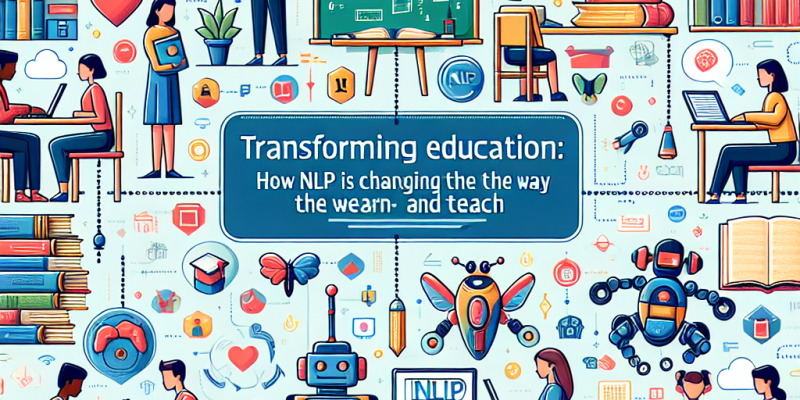Transforming Education: How NLP is Changing the Way We Learn and Teach

Transforming Education: How NLP is Changing the Way We Learn and Teach
In recent years, the landscape of education has been profoundly transformed by advancements in technology, with Natural Language Processing (NLP) emerging as a game-changing innovation. As an area of artificial intelligence, NLP allows machines to understand, interpret, and generate human language. As we delve into the transformative potential of NLP in education, it becomes evident that this technology is reshaping the way we learn, teach, and interact within educational environments.
The Rise of NLP in Education
NLP’s integration into educational systems has gained momentum through the proliferation of digital tools, online learning platforms, and artificial intelligence applications. These innovations are not merely additions to traditional teaching methods; they are catalysts for a fundamental shift in pedagogical approaches. From personalized learning experiences to automated administrative tasks, NLP is enhancing the educational experience for both students and educators.
Personalizing Learning Experiences
One of the most significant impacts of NLP on education is its ability to personalize learning. Traditional one-size-fits-all approaches often fall short of accommodating individual learning styles and paces. NLP addresses this challenge by analyzing student data, including learning behavior and preferences.
For instance, AI-driven learning platforms equipped with NLP can provide customized reading materials, tailored assessments, and adaptive learning paths. By this means, students receive targeted support based on their unique needs, which boosts engagement and retention. For example, tools like intelligent tutoring systems leverage NLP to interact with students, offering real-time feedback and creating a more interactive learning experience.
Enhancing Communication and Collaboration
Effective communication is a cornerstone of successful education. NLP tools break down language barriers through real-time translation, providing equitable access to knowledge for non-native speakers. Students can engage with content and peers in their own language, fostering inclusivity in diverse classrooms.
Additionally, NLP facilitates collaboration among students and educators through intelligent chatbots and communication platforms. Chatbots can assist in answering frequently asked questions, providing information on assignments, and guiding students in their learning journey. This availability of support allows teachers to focus on more complex aspects of instruction while ensuring that students receive timely assistance.
Automating Administrative Tasks
Educators often bear a heavy load of administrative responsibilities, from grading assignments to managing communications. NLP streamlines these tasks, reducing the administrative burden on teachers and freeing up time for more impactful instructional activities. For instance, automated essay scoring systems apply NLP to evaluate student writing based on grammar, coherence, and argumentation, providing instant feedback to learners.
Furthermore, sentiment analysis tools powered by NLP can evaluate student feedback and engagement levels, allowing educators to gauge the effectiveness of their teaching methods. This data-driven approach empowers educators to refine their strategies, ultimately enhancing the educational experience.
Fostering Critical Thinking and Creativity
Contrary to concerns that technology could stifle creativity, NLP encourages critical thinking and innovation. By providing students with various perspectives and resources, NLP-based platforms inspire learners to engage with diverse viewpoints. Automated tools that summarize information or generate writing prompts can stimulate creativity, prompting students to explore topics in-depth.
Moreover, NLP applications can analyze large datasets, enabling learners to conduct research efficiently. The ability to extract relevant information from vast amounts of text empowers students to engage critically with sources and contribute meaningfully to discussions.
Challenges and Considerations
While the benefits of NLP in education are compelling, there are challenges and ethical considerations that must be addressed. Concerns about data privacy, algorithmic bias, and the potential over-reliance on technology must be taken into account. Ensuring that NLP tools are designed with inclusivity and fairness in mind is paramount to their successful implementation in educational settings.
Conclusion
As we stand on the threshold of an educational revolution driven by technology, Natural Language Processing is poised to play a central role in reshaping how we learn and teach. By personalizing learning experiences, enhancing communication, streamlining administrative tasks, and fostering critical thinking, NLP is creating a more dynamic and inclusive educational landscape.
Educators, administrators, and policymakers must embrace this transformation while cautiously addressing potential challenges. By harnessing the power of NLP, we can help unlock the full potential of every learner, paving the way for a more equitable and effective education system that prepares students for the complexities of an ever-changing world. In this new era, the fusion of human intellect and machine learning promises to redefine the future of education for generations to come.














